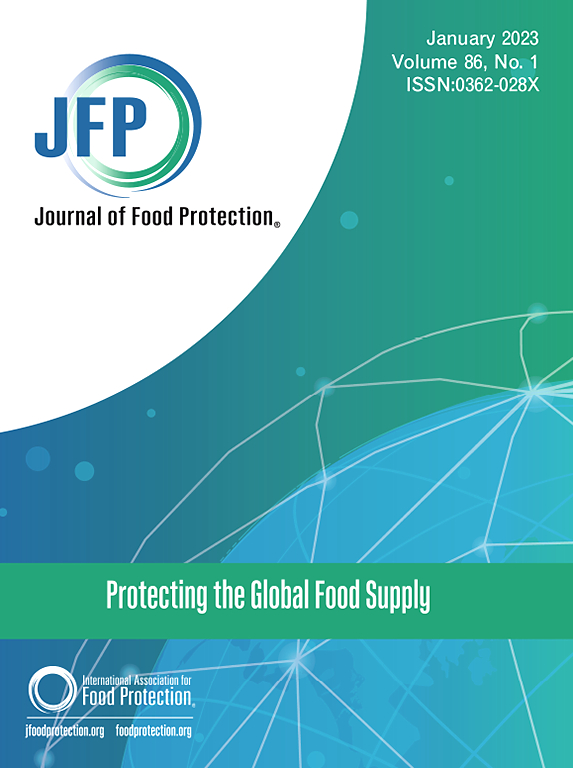实施生产食品安全规范的动机和障碍。
IF 2.8
4区 农林科学
Q3 BIOTECHNOLOGY & APPLIED MICROBIOLOGY
引用次数: 0
摘要
这项研究利用了一组独特的原始数据,这些数据是从向美国市场销售的农产品种植者那里收集的。该研究评估了农场生产安全实践的实施情况,确定了迄今为止种植者面临的最大挑战,并探讨了进一步采用新实践的障碍。大多数受访者报告说,他们在农场实施了农产品安全措施。确定的主要挑战包括记录保存、野生动物和驯养动物、工人健康和卫生培训以及特定工作的农产品安全工人培训。采取生产安全做法的动机包括遵守法规、个人对生产安全的承诺、保持市场准入和减少责任。时间和资金限制是所有食品安全实践中最常见的障碍,其影响因具体实践而异。调查结果强调了推广和支持在实施农产品安全实践方面继续面临困难的种植者的重要性。提供以证据为基础的教育,简化采用降低风险的工具和技术,有助于加强生产安全和公共卫生。此外,针对脆弱性、行为改变因素和具有成本效益的缓解战略的针对性研究可以帮助种植者有效地识别风险并实施安全做法。本文章由计算机程序翻译,如有差异,请以英文原文为准。
Motivations and Barriers to Implementing Produce Food Safety Practices
This study utilizes a unique set of primary data collected from produce growers who sell to U.S. markets. The research assesses the implementation of on-farm produce safety practices, identifies the biggest challenges faced by growers to date, and explores barriers to further adoption of new practices. The majority of survey respondents reported implementing produce safety practices on their farms. Key challenges identified include recordkeeping, wildlife and domesticated animals, worker health and hygiene training, and job-specific produce safety worker training. Motivators for adopting produce safety practices include regulatory compliance, personal commitment to produce safety, maintaining market access, and reducing liability. Time and financial constraints were the most commonly reported barriers across all food safety practices, with the impact varying depending on the specific practice. The findings highlight the importance of outreach and support for growers who continue to face difficulties in implementing produce safety practices. Providing evidence-based education that simplifies the adoption of risk-reducing tools and techniques supports enhancing produce safety and public health. Additionally, targeted research focusing on vulnerabilities, behavioral change factors, and cost-effective mitigation strategies can assist growers in effectively identifying risks and implementing safety practices.
求助全文
通过发布文献求助,成功后即可免费获取论文全文。
去求助
来源期刊

Journal of food protection
工程技术-生物工程与应用微生物
CiteScore
4.20
自引率
5.00%
发文量
296
审稿时长
2.5 months
期刊介绍:
The Journal of Food Protection® (JFP) is an international, monthly scientific journal in the English language published by the International Association for Food Protection (IAFP). JFP publishes research and review articles on all aspects of food protection and safety. Major emphases of JFP are placed on studies dealing with:
Tracking, detecting (including traditional, molecular, and real-time), inactivating, and controlling food-related hazards, including microorganisms (including antibiotic resistance), microbial (mycotoxins, seafood toxins) and non-microbial toxins (heavy metals, pesticides, veterinary drug residues, migrants from food packaging, and processing contaminants), allergens and pests (insects, rodents) in human food, pet food and animal feed throughout the food chain;
Microbiological food quality and traditional/novel methods to assay microbiological food quality;
Prevention of food-related hazards and food spoilage through food preservatives and thermal/non-thermal processes, including process validation;
Food fermentations and food-related probiotics;
Safe food handling practices during pre-harvest, harvest, post-harvest, distribution and consumption, including food safety education for retailers, foodservice, and consumers;
Risk assessments for food-related hazards;
Economic impact of food-related hazards, foodborne illness, food loss, food spoilage, and adulterated foods;
Food fraud, food authentication, food defense, and foodborne disease outbreak investigations.
 求助内容:
求助内容: 应助结果提醒方式:
应助结果提醒方式:


